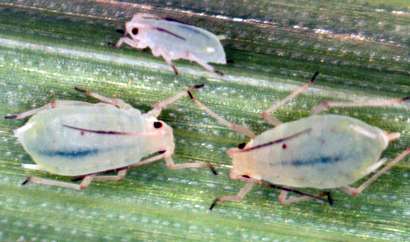Open-access article takes a closer look at crop-damaging greenbugs

Aptly named for their bright lime color, greenbugs (Schizaphis graminum) have been a major vexation for growers of wheat and sorghum for more than half a century, especially in the Great Plains. As decades of research into the little aphids have accumulated, the time has come for an overview of the little aphid and a summary of control methods, according to Dr. Tom Royer, professor and IPM coordinator at Oklahoma State University. He is the lead author of a new paper on these insects in the open-access Journal of Integrated Pest Management.
"This was a good opportunity to summarize the literature, and just keep things up to date on this pest," he explained.
One of the interesting aspects of the greenbug is its wide host range and how it manages to do so well in spite of different control measures, Royer said, noting that the aphid will attack not only winter wheat and sorghum, but also other small grains and some turfgrasses. Originally, scientists thought that greenbugs evolved adaptations to newly developed resistant plants or pesticides. The greenbugs that could not overcome the new resistances or pesticides would perish, while the remainder would survive and thrive, passing their superior characteristics on to the next generations, making them harder and harder to control over time.
That is not, however, what is actually happening, according to Dr. Royer.
"A lot of research now supports the idea that greenbugs are so-called pre-adapted opportunists, which means they already have a lot of different genetic diversity within the species—the variety of characteristics is already there—so based on what we're planting in the field at the time, certain populations simply take the opportunity to succeed," he explained. In other words, greenbug populations rotate, with different populations flourishing when their particular genetic characteristics give them the edge.
Another characteristic of this formidable pest is the damage it inflicts on plants while it feeds. Something in its saliva imparts visible injury to a plant, leaving behind noticeably yellowed leaves.
"We've always thought that it probably has some kind of toxic interaction with the plant," Royer said. So far, however, researchers still aren't sure exactly what is going on, so that work is continuing.
Control of greenbugs remains a challenge, but growers can take steps to keep the insects in check. One method is to plant wheat a little later in the year to avoid early greenbug colonization, but the best approach is to monitor the wheat fields to determine when pesticides make sense, according to Royer. To do that, he advocates the use of Oklahoma State's Glance n' Go system, which he helped to develop over the past decade. The Glance n' Go system typically requires no more than 15 minutes of surveying plants for greenbugs that are either alive or "mummified." Mummified greenbugs signify the presence of their natural enemy, a parasitoid wasp known as Lysiphlebus testaceipes. Growers upload information on their location, time of year, current price of wheat, and control costs into the Glance n' Go system's website, which analyzes the data and calculates a treatment threshold. They can then print a scouting form and take it into the field to determine which areas need to be sprayed.
"That means producers treat only those fields that need it," Royer said.
While scanning the literature for the JIPM article, Royer was as impressed with the people behind the research as he was with the biology and the tenacity of the greenbug itself.
"I saw the work of all of these people that I very much admired, including entomologists like George Teetes, who was president of the Entomological Society of America; Don Peters and Kris Giles here at OSU; some of my colleagues, including Bonnie Pendleton, who was a student of Dr. Teetes; Norm Elliott and other members of the USDA's Agricultural Research Services lab in Oklahoma; and entomologists at Kansas State, Texas A&M, and OSU. The researchers who did the work are people who I'd almost call legends in entomology, so it was really humbling for me to write the article."
More information: T. A. Royer et al. Greenbug (Hemiptera: Aphididae) Biology, Ecology, and Management in Wheat and Sorghum, Journal of Integrated Pest Management (2015). DOI: 10.1093/jipm/pmv018
Provided by Entomological Society of America



















